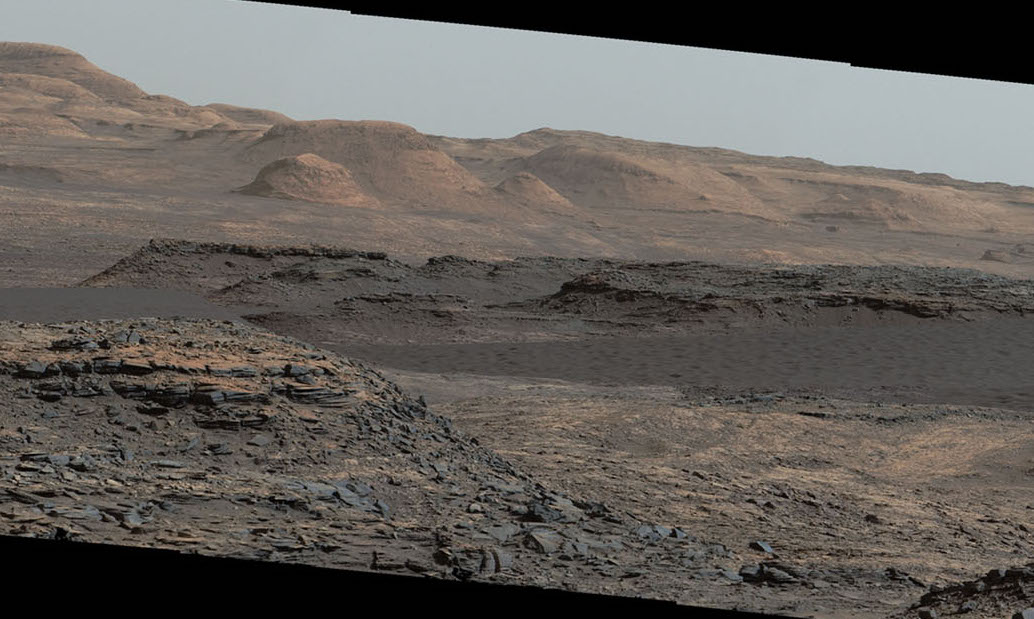
Mars is often referred to as a desert world, being bone-dry for the most part, with dust and sand blanketing most of the surface. Some regions are covered in vast sand dunes, reminiscent of deserts like the Sahara on Earth, only much colder. Gale crater, where the Curiosity rover landed in 2012, features extensive dune fields around the base of Mount Sharp, and the rover is now approaching some of them for the first time; their dark color makes them stand out starkly against the surrounding terrain. These dunes are also still active, meaning they are still mobile and shaped by the wind, not just old “fossil” (petrified) dunes which are no longer active.
This will be the first time that a rover has examined such dunes on Mars, instead of just smaller ripples or drifts, the kind which Opportunity and Spirit have seen, as well as the Viking landers. The dunes which Curiosity is approaching are called the Bagnold Dunes, on the northwestern side of Mount Sharp; one of them is as tall as a two-story building and as wide as a football field. The dunes are named after Ralph Bagnold (1896-1990), a British engineer who pioneered the field of studying the effect of wind on the motion of individual particles in dunes.
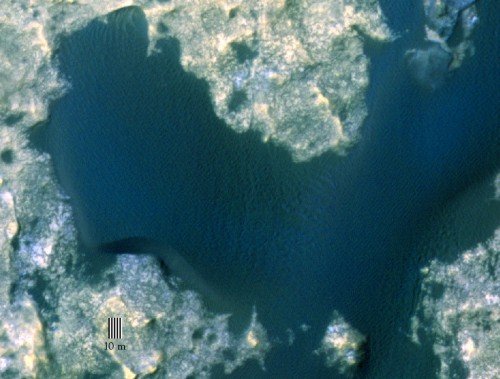
“We’ve planned investigations that will not only tell us about modern dune activity on Mars but will also help us interpret the composition of sandstone layers made from dunes that turned into rock long ago,” said Bethany Ehlmann of the California Institute of Technology and NASA’s Jet Propulsion Laboratory, both in Pasadena, Calif.
Observations from orbiting spacecraft have indicated that these dunes are migrating as much as 3 feet (1 meter) per Earth year.
The first dune that Curiosity will look at is called “Dune 1,” where the rover will scuff the edge of the dune with its wheels as well as collect samples to be analyzed. Orbital observations by the Mars Reconnaissance Orbiter (MRO) have already shown that the mineral composition in the dunes is not evenly distributed.
“We will use Curiosity to learn whether the wind is actually sorting the minerals in the dunes by how the wind transports particles of different grain size,” Ehlmann said.
The dunes are also known to contain the mineral olivine, which can easily be altered by water into different minerals. Scientists will examine the data from Curiosity to see if other mineral grains have been separated from the heavier olivine grains by wind. If so, that could also provide a clue as to what extent olivine in ancient sandstones have been sorted by wind and not just water in the past.
It will be interesting to compare the studies of these Martian dunes to ones on Earth, since Mars has lower gravity and a thinner atmosphere.
According to Nathan Bridges of the Johns Hopkins University’s Applied Physics Laboratory, Laurel, Md., “These dunes have a different texture from dunes on Earth. The ripples on them are much larger than ripples on top of dunes on Earth, and we don’t know why. We have models based on the lower air pressure. It takes a higher wind speed to get a particle moving. But now we’ll have the first opportunity to make detailed observations.”
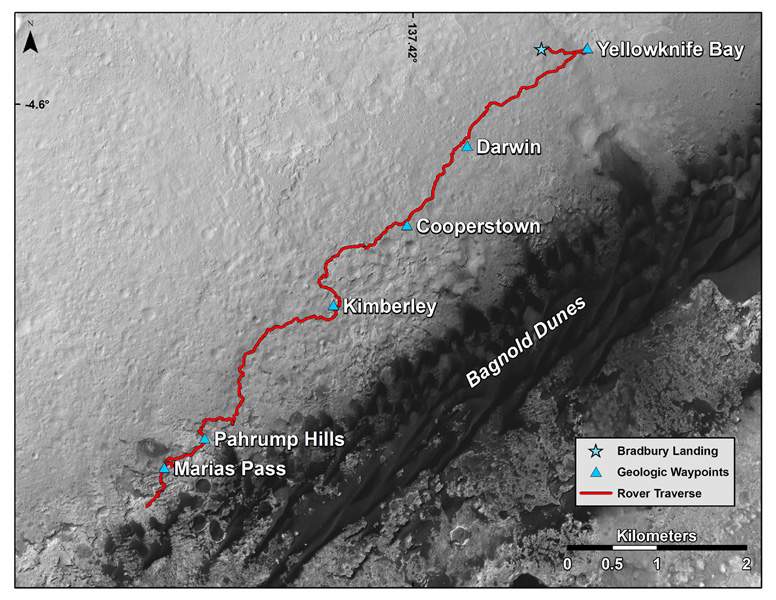
Larger dunes are different from smaller ripples or drifts in that they form steep downwind faces where sand can slide down. Curiosity had also earlier examined some of the “fossil” (petrified) dunes in the Stimson sandstone outcrop which initially formed as sand dunes but then became cemented into rock. The sandstone overlies a layer of mudstone.
The new dunes study comes just days after finishing the two latest drilling campaigns only 18 days apart, the closest between two such drillings so far in the mission. Curiosity has now drilled rocks at nine locations since landing; the ninth location is called “Greenhorn” and the eighth was “Big Sky.”
“With Big Sky, we found the ordinary sandstone rock we were looking for,” said Curiosity Project Scientist Ashwin Vasavada. “It also happens to be relatively near sandstone that looks as though it has been altered by fluids – likely groundwater with other dissolved chemicals. We are hoping to drill that rock next, compare the results, and understand what changes have taken place.”
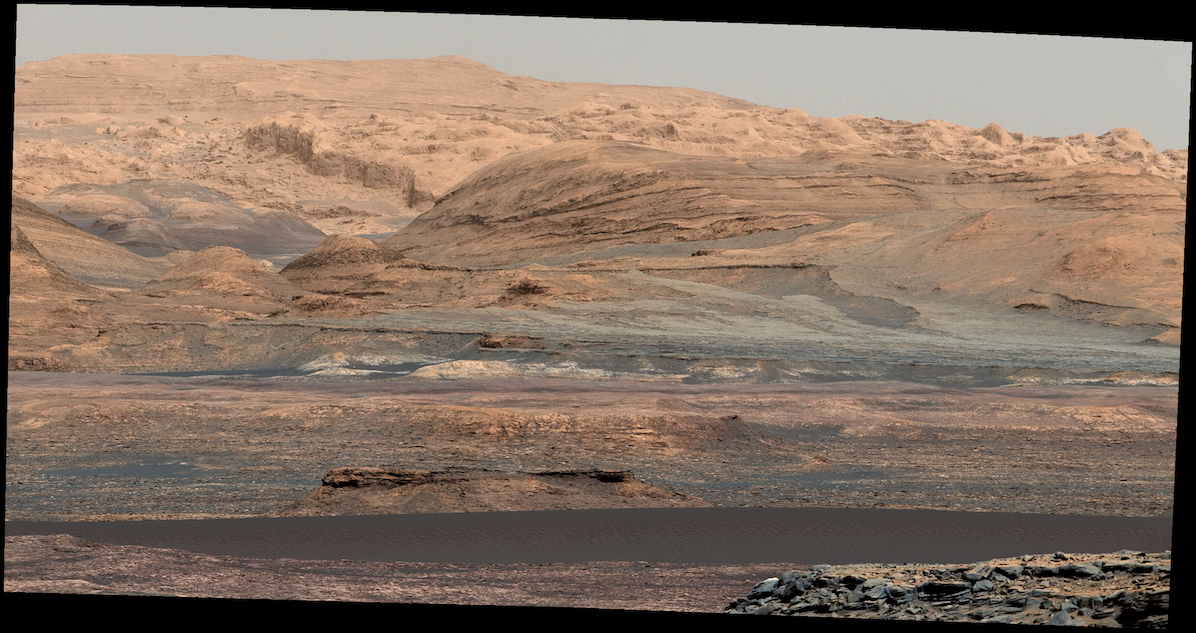
Analysis of the Big Sky and Greenhorn rock-powder samples by CheMin and SAM will continue over the next few weeks as the rover continues its journey to the dunes.
While still in this area, Curiosity also took a stunning new panorama showing the buttes and mesas in the foothills of Mount Sharp, a scene very reminiscent of the American southwest. In the foreground is a long ridge rich in hematite, then behind that a large plain with high levels of clay minerals and then in the background the buttes which are high in sulphate minerals. The differences record a changing environment in the distant past in this region.
“The only thing more stunning than these images is the thought that Curiosity will be driving through those lower hills one day,” Vasavada said. “We couldn’t help but send a postcard back to all those following her journey.”
Curiosity has also recently confirmed ancient lakes in Gale crater, meaning that this region was once potentially much more habitable than it is now. It is amazing to think that the area where Curiosity is roving now used to be a lake bottom.
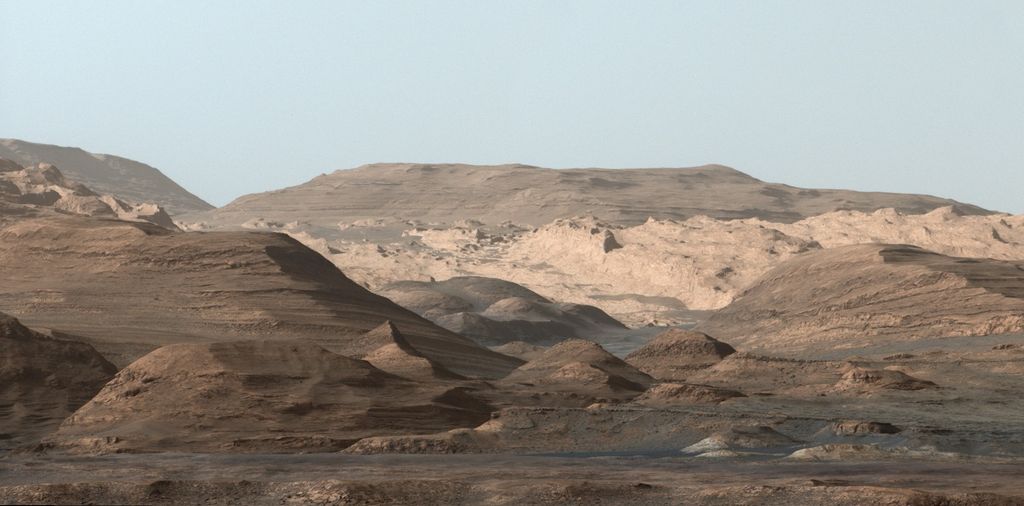
“What we thought we knew about water on Mars is constantly being put to the test,” said Michael Meyer, lead scientist for NASA’s Mars Exploration Program at NASA Headquarters in Washington. “It’s clear that the Mars of billions of years ago more closely resembled Earth than it does today. Our challenge is to figure out how this more clement Mars was even possible, and what happened to that wetter Mars.”
Other recent studies have also shown that there were once multiple episodes of water moving through bedrock as well, leaving behind mineral-rich veins in the rocks which Curiosity has also been studying, in particular at a location called “Garden City.” Curiosity was at this location back in March 2015, but analysis of the data obtained has been on-going since then.
“These fluids could be from different sources at different times,” said Diana Blaney, a Curiosity science team member at NASA’s Jet Propulsion Laboratory, Pasadena, Calif. “We see crosscutting veins with such diverse chemistry at this localized site. This could be the result of distinct fluids migrating through from a distance, carrying chemical signatures from where they’d been.”
More information about the Curiosity rover mission is available here.
Want to keep up-to-date with all things space? Be sure to “Like” AmericaSpace on Facebook and follow us on Twitter: @AmericaSpace
Missions » InSight » Missions » MAVEN »



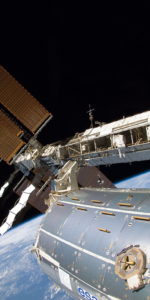
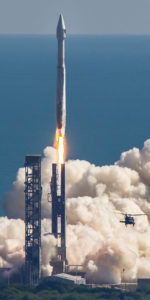
My wife and I have a strong emotional attachment to this mission – we were at CCAFS for the MSL launch, and we were at JPL when CURIOSITY landed on Mars. What a stunning mission!
Thank you for the article Paul Scott Anderson!
Lovely pictures.
Mars needs a much thicker atmosphere for protection from Galactic Cosmic Radiation. That will be a good project for future generations.